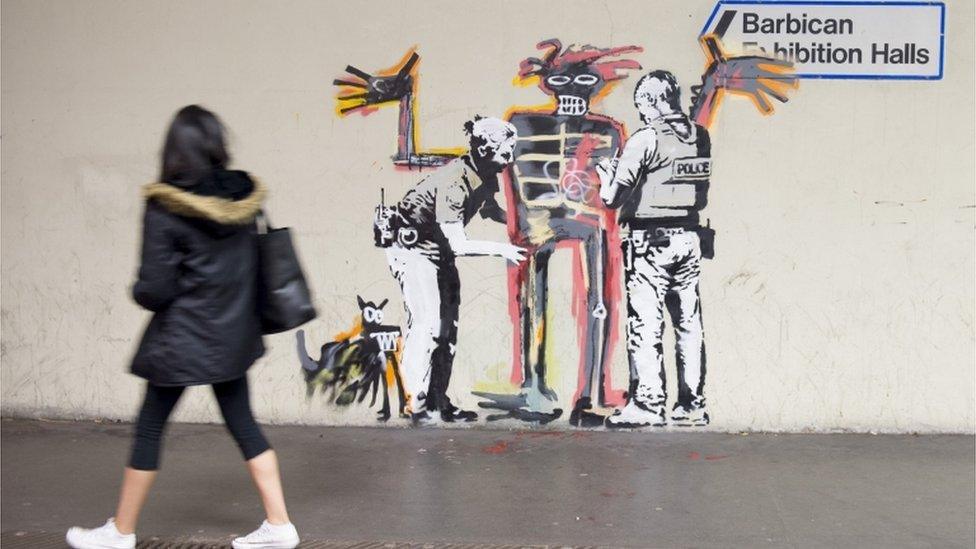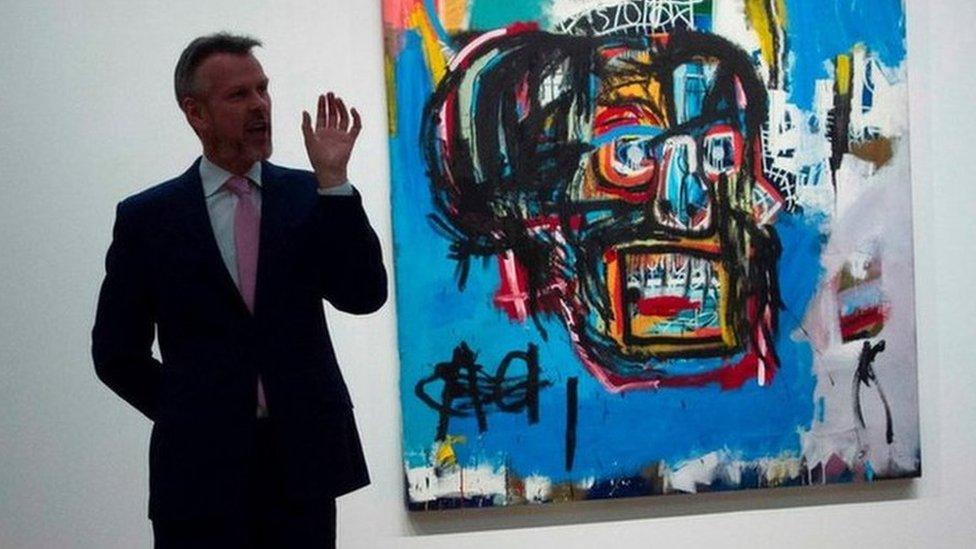The 'Jimi Hendrix of art'
- Published

The exhibition of more than 100 pieces of Jean-Michel Basquiat's artwork at the Barbican is going to be a hit show.
It's not faultless - the Barbican galleries are not easy spaces - but it is very good, added to which, it's jam-packed with Basquiat works that haven't been seen in the UK before.
Those he produced in the early 80s have a power and directness that wallops you between the eyes. He is taking on Dubuffet, Twombly and Picasso, and in some aspects, bettering them all.
These are the bold, crude, naive paintings of a talented, angry, ambitious young black man.
The later works don't have quite the same oomph - they feel self-derivative. Maybe that's down to his close friendship with Andy Warhol, the artist-cum-businessman, who one can imagine encouraged the 20-something artist to trade heavily.
All art exhibitions are, to a greater or lesser extent, about myth-making. Curators like to place their subjects on pedestals, to elevate the artist to a position of a semi-deity. We are invited in to worship.
Legendary figure
The Barbican's Jean-Michel Basquiat show is no different. There are vitrines full of ephemera evoking the mood of New York's downtown scene of the late 1970s - where Basquiat was a major player - or in museum parlance, a legendary figure.
There's jazz music blaring out of the gallery speakers and huge archive photos of the long-dead artist in his pomp. We are being worked on.
But that's OK, in this instance, because Basquiat was there first.
From his early days as a teenage graffiti writer operating under the pen-name Samo, spraying his poetic verses on the brick walls of downtown Manhattan, the Brooklyn-born artist was busy creating his own myth.

He was a man with a plan. He would boast to fellow hipsters about how famous he would become.
Michael Holman, with whom Basquiat formed the alt-rock band Gray in 1979, said that all the other artists at that time in New York were making work to attract the attention of the 400 or so other characters making up the downtown scene.
Not Basquiat. "He was looking way past that," said Holman. "He was looking at global domination."
He has eventually found that, nearly 30 years after his death from a heroin overdose, making him a member of the tragic 27 Club.
Basquiat has been called the Jimi Hendrix of art, the post-modern Picasso, and America's first truly important black painter. All have a whiff of myth-making about them, while also possessing a ring of truth.
I'm not sure any of those descriptions would spring to your mind if you went round the Barbican show with little prior knowledge of the Basquiat legend.
I suspect it would be the directness and freshness of his early work that would stay with you - the feeling that you'd seen good examples of a great artist who created a new visual language to synthesise the political, social and cultural landscape of America in the late 70s and early 80s in a vivid aesthetic no other artist could even begin to match.
The exhibition Basquiat: Boom for Real is at London's Barbican Art Gallery from 21 September to 28 January.

Follow us on Facebook, external, on Twitter @BBCNewsEnts, external, or on Instagram at bbcnewsents, external. If you have a story suggestion email entertainment.news@bbc.co.uk.
- Published18 September 2017

- Published19 May 2017

- Published19 May 2017